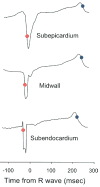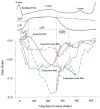Transmural dispersion of myofiber mechanics: implications for electrical heterogeneity in vivo
- PMID: 17320750
- PMCID: PMC2572715
- DOI: 10.1016/j.jacc.2006.07.074
Transmural dispersion of myofiber mechanics: implications for electrical heterogeneity in vivo
Abstract
Objectives: We investigated whether transmural mechanics could yield insight into the transmural electrical sequence.
Background: Although the concept of transmural dispersion of repolarization has helped explain a variety of arrhythmias, its presence in vivo is still disputable.
Methods: We studied the time course of transmural myofiber mechanics in the anterior left ventricle of normal canines in vivo (n = 14) using transmural bead markers under biplane cineradiography. In 4 of these animals, plunge electrodes were placed in the myocardial tissue within the bead set to measure transmural electrical sequence.
Results: The onset of myofiber shortening was earliest at endocardial layers and progressively delayed toward epicardial layers (p < 0.001), resulting in transmural dispersion of myofiber shortening of 39 ms. The onset of myofiber relaxation was earliest at epicardial layers and most delayed at subendocardial layers (p = 0.004), resulting in transmural dispersion of myofiber relaxation of 83 ms. There was no significant transmural gradient in electrical repolarization (p = NS).
Conclusions: Despite lack of evidence of significant transmural gradient in electrical repolarization in vivo, there is transmural dispersion of myofiber relaxation as well as shortening.
Figures








Comment in
-
Of that Waltz in my heart.J Am Coll Cardiol. 2007 Feb 27;49(8):917-20. doi: 10.1016/j.jacc.2006.12.006. Epub 2007 Feb 9. J Am Coll Cardiol. 2007. PMID: 17320751 No abstract available.
-
On the mechanisms of transmural dispersion of myocardial mechanics.J Am Coll Cardiol. 2007 Aug 14;50(7):649-50; author reply 650. doi: 10.1016/j.jacc.2007.03.061. Epub 2007 Jul 30. J Am Coll Cardiol. 2007. PMID: 17692752 No abstract available.
References
-
- Antzelevitch C, Fish J. Electrical heterogeneity within the ventricular wall. Basic Res Cardiol. 2001;96:517–27. - PubMed
-
- Sicouri S, Antzelevitch C. A subpopulation of cells with unique electrophysiological properties in the deep subepicardium of the canine ventricle. The M cell Circ Res. 1991;68:1729–41. - PubMed
-
- Antzelevitch C, Shimizu W, Yan GX, et al. The M cell: its contribution to the ECG and to normal and abnormal electrical function of the heart. J Cardiovasc Electrophysiol. 1999;10:1124–52. - PubMed
-
- Yan GX, Antzelevitch C. Cellular basis for the normal T wave and the electrocardiographic manifestations of the long-QT syndrome. Circulation. 1998;98:1928–36. - PubMed
Publication types
MeSH terms
Grants and funding
LinkOut - more resources
Full Text Sources
Other Literature Sources
Miscellaneous

